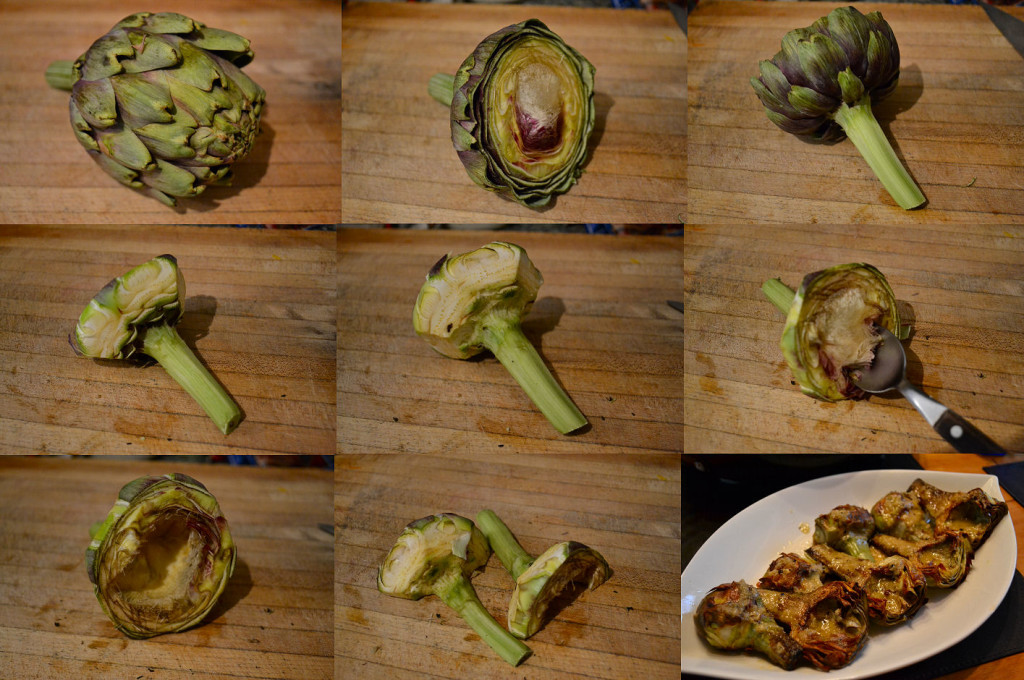On Sunday supplement
Food and Wine
When the same question pops up in your life several times in one week, with no particular impetus, the universe is trying to tell you something. Or, it’s just a coincidence. Pretty much the same thing. But it does get you thinking, or me thinking. So when three different people this week asked me “How do you prepare an artichoke?” it became a part of my daily thoughts. Fit in somewhere around waiting six days for the local cable conglomerate to get around to fixing service here in the ‘hood.
It’s one of those things I learned to do in cooking school a long time… more than a generation, ago. Maybe two. And it became something that I simply do, without thinking about it. But I get it, I mean, who thinks about preparing an artichoke? They’re pretty, but they’re daunting. It’s probably why my mother never did anything with them but snip off the tips of the “leaves” and then steam the heck out of them so that we could pluck them and scrape off the juicy “meat” at the bottom. I never had an artichoke any other way until I was out in the world, working in the restaurant industry.
So first off, just what is an artichoke? We’ve all seen them. Right now they’re in season here in BA and piled high in every verdulería. A month ago my neighborhood stand was selling them for 7 pesos apiece. This morning they were offering them up 4 for 10. Look at them closely – they look like a sort of scaly greenish pinecone or maybe something out of Avatar. What they are is a flower. A thistle flower. Actually, an immature flower surrounded by protective leaves. Now, as to what artichokes think they need protection from, I have no idea. But they’re protected.
There are several kinds of artichokes out there, either green or purple or a mix. All of them originated in Sicily, and from there, spread to wherever Sicilians and then later, Italians spread. The large green ones we see here are either the Camus de Bretagne or the Blanca de Tudela variety – I doubt I could tell the difference side by side, the biggest difference is simply size – unless you want to get into DNA testing. Argentina and Chile combined produce about 36% of the world’s artichokes. Who knew?
So, let’s get to it. I’ve provided a sort of step-by-step photo guide to see what the vegetable should look like after each process. Hopefully that’ll help.
1) set your artichoke on a cutting board. 2) using a large, sharp knife, cut across it about 2 cm from the base of the flower. 3) Turn it around and using a vegetable peeler, peel the stem down to the light green inner part (which is edible too). 4) Back to that big knife, place the cut side of the artichoke down on the board and just cut around on an angle, taking off the leaves and exposing the outer edge of the heart. 5) With a small knife, basically scrape out the seam between the stem and the heart that you can’t quite get to with either peeler or the big knife. 6) Get a spoon and stick in alongside the hairy “choke” in the center and then work it around in a circle to scoop out the choke. 7) Use the spoon to scrape out any remaining hairs, so to speak. 8) For this recipe, cut it in half lengthwise – though this will depend on what you’re going to make with them – and, stick them in a bowl of water with some lemon juice or vinegar to prevent them from turning brown in the air.
Artichokes “in Escabeche”
8 artichokes (1 little over a kilo)
1 lemon, cut in half and squeezed into a large bowl of water
240 ml extra virgin olive oil
1 bay leaf
3 large cloves garlic, peeled
½ teaspoon salt
1 tablespoon good quality sherry or fruit vinegar and more for drizzling
Extra virgin olive oil for drizzling
Prepare the eight artichokes as above and put in the bowl with the lemon water.
In a skillet, heat the olive oil over medium to medium-high heat until nearly smoking, about 10 minutes of preheating, then cook the artichoke hearts with the bay leaf until golden brown on the outside and until a skewer or knife tip glides to the center of the artichoke heart without too much resistance, about 5 to 6 minutes. Remove from the oil with tongs or a slotted spoon and transfer to a shallow serving platter or bowl.
Meanwhile, pound the garlic with the salt in a mortar. Stir 3 tablespoons of the oil you cooked the artichokes in into the garlic, ½ tablespoon at the time. Now, stir in the vinegar ½ teaspoon at a time until the garlic is a creamy looking sauce. Spoon small amounts of this mixture over the artichokes. Drizzle the artichokes with olive oil and a splash of vinegar and set aside to cool and absorb flavors before serving. Season with salt and pepper if necessary.
A series of recipes and articles that I started writing for the Buenos Aires Herald Sunday supplement, Food & Wine section, at the beginning of 2012. My original proposal to them was to take local favorite dishes and classics and lighten them up for modern day sensibilities. We’re not talking spa or diet recipes, but at the very least, making them healthier in content, particularly salt, fat and portion size. As time went by, that morphed into a recipe column that, while emphasizing food that is relatively “good for you”, wasn’t necessarily focused on local cuisine. At the beginning of 2013 I decided to stop writing for them over some administrative issues, but it was fun while it lasted.
